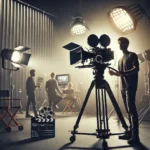Watching a film is a highly immersive experience, but analyzing it takes you beyond the surface. Film analysis is the key to unlocking deeper meanings, revealing how directors, writers, and actors use every element at their disposal to create a complete cinematic experience. From themes that resonate on a personal and societal level to the subtle ways cinematography and sound can manipulate emotions, understanding how to analyze a film enhances your appreciation of the medium.
This article will guide you through the fundamental elements of film analysis: from uncovering a film’s central themes to examining the visual and auditory techniques used. By the end, you’ll have the tools to approach any film with a critical eye, allowing you to enjoy cinema on a much deeper level.
Understanding Themes in Films
At the core of any film lies a theme—a central idea or message that the filmmaker aims to communicate. Themes are often universal and timeless, touching on concepts like love, revenge, freedom, or the struggle for power. These thematic undercurrents provide the foundation for the narrative and emotional weight of the film.
Identifying the theme is essential for analyzing a film. Sometimes, it’s explicitly stated through dialogue or plot, while other times, it’s more subtly conveyed through the characters’ actions or the film’s visual symbolism. A good approach is to ask yourself: “What is this film really about?” Is it exploring the consequences of greed, the fragility of human relationships, or the fight for justice?
For example, consider The Godfather, a film that revolves around family and power. While the story depicts the rise of Michael Corleone within the mafia, the central theme of power—how it’s gained, maintained, and corrupts—underpins the entire narrative. By focusing on the theme, we can understand why the characters make the choices they do and how their desires for power shape the tragic trajectory of the story.
Narrative Structure
The narrative structure is the blueprint that determines how a film’s story unfolds. Most films follow a three-act structure: the beginning (introduction), the middle (conflict), and the end (resolution). However, there are many variations to this, such as non-linear narratives that jump back and forth in time or fragmented storytelling that reveals pieces of the plot out of order.
Understanding how a film’s narrative is structured helps reveal how the story builds tension, creates emotional beats, and ultimately resolves. A linear narrative provides clarity, taking viewers on a straightforward journey from start to finish. Non-linear stories, on the other hand, can create intrigue by withholding information and encouraging viewers to piece together the story themselves.
A great example of non-linear storytelling is Quentin Tarantino’s Pulp Fiction. The film’s storylines are interwoven, and the audience is not shown events in chronological order. Instead, Tarantino crafts the narrative like a puzzle, with each section revealing new information that enhances the overall understanding of the plot. The non-linear structure not only adds suspense but also reflects the chaotic lives of its characters.
Character Development and Acting
Characters are the heart of any film, and their development over the course of the story often reflects the film’s themes. Strong character development is essential for audiences to connect emotionally with the story, and it often follows an arc where the character grows, changes, or experiences a crisis that tests their values.
When analyzing character development, consider how the protagonist’s journey aligns with the film’s message. Look at their motivations, relationships, and decisions. Are they consistent, or do they evolve as the plot progresses?
Acting is another crucial aspect to analyze. An actor’s ability to convey emotions through facial expressions, body language, and voice can elevate the storytelling. When examining a performance, think about how the actor embodies their character. Do they make you believe in their struggles, fears, and triumphs?
A prime example of character development can be found in the TV series Breaking Bad, where Walter White’s transformation from a humble chemistry teacher into a ruthless drug kingpin is a masterclass in character evolution. His descent into moral corruption is driven by his thirst for power, and this aligns perfectly with the show’s central theme of how far a person will go when pushed to their limits.
Cinematography and Visual Storytelling
Cinematography is the art of visual storytelling, where each shot, frame, and lighting choice contributes to the film’s mood and meaning. The visuals can be as important as the dialogue, often conveying emotions or themes without a single word spoken.
Key elements to focus on in cinematography include lighting, color palettes, framing, and camera angles. Each of these elements is a tool for the filmmaker to create atmosphere and guide the viewer’s emotional response.
Take Steven Spielberg’s Schindler’s List, for example. The use of black-and-white cinematography emphasizes the bleakness of the Holocaust, while the choice to highlight the girl in the red coat creates a stark symbol of innocence amidst the horrors. This visual technique underscores the emotional and thematic weight of the film in a way that words alone could not achieve.
Additionally, pay attention to camera movements and angles. A low-angle shot can make a character seem powerful or intimidating, while a close-up reveals intimate emotions. In Citizen Kane, Orson Welles uses deep focus shots to keep multiple elements in sharp detail, emphasizing the complexity of the characters’ relationships and the layers of the story.
Sound and Music
Sound plays an essential role in how we experience a film, often guiding our emotions and setting the tone. Both diegetic sound (sound that originates within the film’s world) and non-diegetic sound (external sound, such as background music) can enhance the narrative.
When analyzing sound in a film, ask yourself: How does the sound design contribute to the story? Music can be used to evoke a particular mood, foreshadow events, or highlight a character’s emotional state. Likewise, silence can be just as powerful, creating tension or emphasizing the gravity of a moment.
For instance, the iconic score of Inception by Hans Zimmer creates a sense of urgency and suspense throughout the film. The deep, resonating brass sounds mirror the concept of time and reality bending, adding an extra layer of tension to the already complex plot.
Editing and Pacing
Editing is the invisible craft that determines the rhythm and pacing of a film. Good editing helps the story flow seamlessly, building tension and keeping the audience engaged.
Different types of editing can evoke different feelings. Fast cuts are often used in action scenes to create excitement, while long takes can immerse the viewer in a particular moment. Pay attention to how scenes transition and the pacing of dialogue or action. Does the editing slow down to allow for reflection, or does it speed up to heighten tension?
Consider the fast-paced, action-heavy editing in Mad Max: Fury Road, where quick cuts and dynamic camera movements keep the audience on the edge of their seat. The frenetic pace of the editing mirrors the chaos of the film’s world and keeps the adrenaline high.
Conclusion
Film analysis is a rewarding practice that can deepen your understanding and enjoyment of cinema. By paying close attention to themes, narrative structure, character development, visual storytelling, sound, and editing, you can unlock layers of meaning that are not immediately apparent on a surface-level viewing.
Whether you’re watching a timeless classic or the latest blockbuster, applying these analytical tools will enhance your appreciation of the art form. So next time you sit down to watch a film, take a moment to think critically about what you’re seeing and hearing—you may discover a whole new world beneath the surface.


